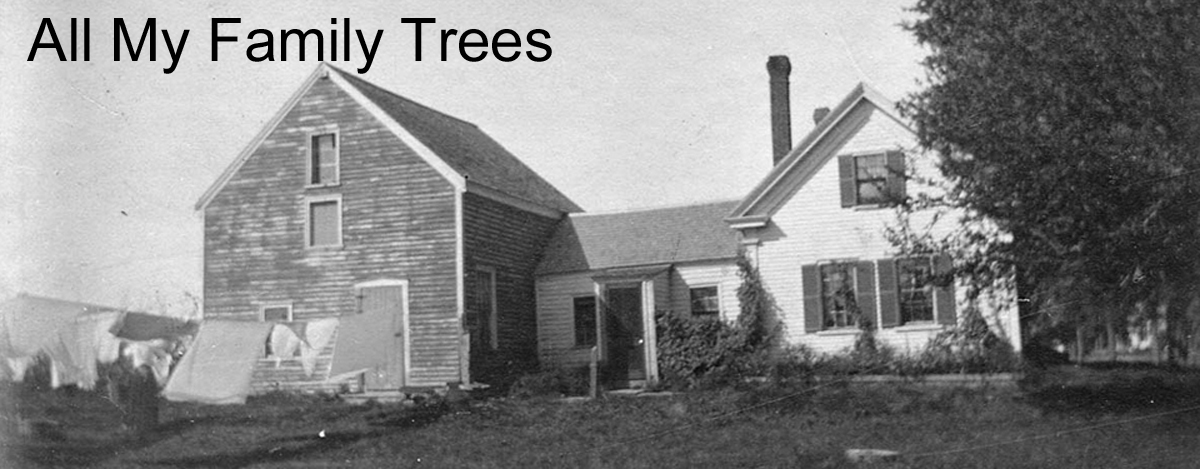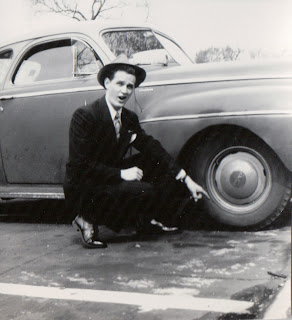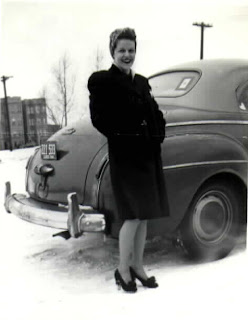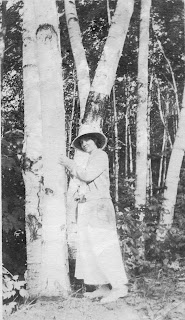 |
| Ethel Jackson about 1910 |
Ethel Jackson, or “Aunt Jack”, was the only sibling of my
great-grandfather Harry Edward Jackson. Harry lived with his family in and
around Boston, Massachusetts until my great-grandmother Frances packed up their
four children and moved to Chicago to live with another man. The children never
saw their father again and no one in the family even knew he had died until Ethel
wrote to them about six months after his death. She had evidently disposed of
all Harry’s assets before informing his family. She was never heard from again
and she died an old maid.
That’s the family legend. This is the real story as it is
gleaned from public records.
Ethel Camilla Jackson, daughter of John Harry Jackson and
Ida Estella Whittemore, was born on 17 September 1886 in Ashland, Middlesex county,
Massachusetts.[1]
Her father had moved to Ashland between 1870 and 1879 where he worked as a hat
blocker and then as a boot maker, probably working in the same boot shop as his
future father-in-law. John and Ida were married in Ashland in 1881 and their
first child Harry followed barely nine months later. It was another four years before
Ethel came along, their second and last child (according to the 1900 and 1910
population schedules, Ida was the mother of two children).
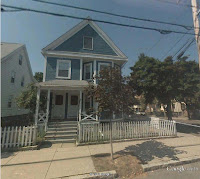 |
| 99 High Street in Malden, Mass as it appears today. (Google Earth) |
By 1900,
John had moved the small family to 99 High Street in Malden, Massachusetts,
abandoning his career in boot making and taking up that of “market meat
cutter”.[2] We next see the family in
1910 residing at 378 Bowdoin Street in
Boston. By this time Harry had married and set up his own household.
Ethel was 23, living at home with her parents, single, and attending school,
presumably college but I have found no direct evidence for that assumption[3].
John died in 1915 at 333 Quincy Street in Boston[4]. In 1920, Ethel and her widowed
mother Ida were lodgers at 16 Sayward Street in Boston. Ida was working as a
stitcher of neckwear and Ethel, still single, was a teacher at a commercial
college.[5] Ida, Ethel, and Harry’s
daughter Signa made a trip out to Coronado Beach, California in June 1922 to
visit Ida’s sister-in-law Annette (Aunt Nettie) Jackson.
| "Coronado Beach Ladies", June 23, 1922: Ida, Nettie, Signa, and Ethel Jackson |
Ida died in 1924[6]. By 1930, Ethel was living
alone at 88 Charles Street, Boston. She was still single and still employed as
a college teacher.[7]
No public records have been found of Ethel for another twelve years so we
switch our focus for a moment to her brother Harry.
Although Harry seems to be absent from the 1930 census, we
know that he was living somewhere in Boston from 1932 to 1936. These were the
years that he was filing divorce claims with the Suffolk County Probate Court.
His initial claim filed in 1932 charged his wife Frances with being unfaithful
in Boston “on or about the 15th day of October 1928” and of being guilty
of “cruel and abusive treatment” of him.[8] Frances and their children
are enumerated in the 1930 census for Chicago with Allan Wendergren, boarder[9], whom we now know to be
her lover.
 |
| Ethel and brother Harry probably late 1930s |
Neither Harry nor Ethel ever saw Harry’s children again and the
family believes that they made very little contact with them from that point
forward. Since none of those children are alive today, we will probably never be
certain if that is true. It is my belief, however, that someone was in
communication with them because we are in possession of some photos of Harry with
his winter home in Florida—something that he did not own before the divorce.
Given the circumstances of the divorce, it is not inconceivable that Ethel
would hold some resentment towards Frances and, by extension, her children.
Both Ethel and Harry are missing from the 1940 census. Harry
died on 27 December 1941 in Tampa, Florida[10] where he spent his
winters in his semi-retirement from the New York, New Haven and Hartford
railroad. Ethel was the informant on Harry’s death certificate and gave her
Boston address as the same as Harry’s usual residence. She also gave his
marital status as ”Married”, although the divorce had been final for nearly ten
years. His body was removed to Ashland, Massachusetts on 2 January 1942 for
burial in his mother’s family plot at Wildwood cemetery. Ethel waited several
months before informing Harry’s children of their father’s death. The family believes she had disposed of his assets before informing them because none of the children
received any of Harry’s personal possessions.[11]
 |
| Harry's winter home in Tampa, Florida |
This is the last any of the grandchildren knew of Ethel—she
was still single when Harry died and as far as the family knew, she never
married. Imagine my surprise when, as I was searching for online records for
Ethel, I found a North Carolina death record for her with the surname Bridgham
and spouse Albert S. [sic] Bridgham.[12] This discovery has made
it possible to find some of the rest of the story.
Albert Fayette Bridgham, son of Levi Bridgham and Fannie
Morrill Bradbury, was born on 11 March 1891 in Dexter, Penobscot county, Maine.[13] He married Emily R.
Malcome (or Malcomb) about 1916 and had two children: Jean A. Bridgham (born
about 1918) and Frederick A. Bridgham (born about 1920)[14]. Albert was a business
school teacher in the Boston area at Burdett College, which has since been
closed.[15] It is possible that Ethel
also taught at that school, which would explain how the two met. Emily died in
1941; Ethel and Albert were married sometime after that and they moved to North Carolina before 1961.
Ethel died on 13 November 1961 in Salisbury, Rowan county,
North Carolina at age 75, and was cremated on 15 November in Winston-Salem, Forsyth county, North
Carolina. The cause of her death was “natural causes - cause undetermined
(sudden)”.[16]
Her ashes are interred in the Bridgham family plot at Mount Pleasant cemetery,
Dexter, Penobscot county, Maine.[17] Albert followed Ethel in death on 29 December
1965 in Salisbury at age 74, and was cremated on 31 December in Winston-Salem.
The cause of his death was “natural causes, causes undetermined, no evidence of
foul play”. [18]
His ashes are also interred in the Bridgham family plot at Mount Pleasant
cemetery in Dexter, Maine.[19]
It is clear that more research must be done to complete
Ethel’s story. It might be interesting to track down Albert’s children or
grandchildren to hear what they know about her. Since none of Harry’s living
descendants ever met her, it would be interesting to get to know the real Aunt
Jack.
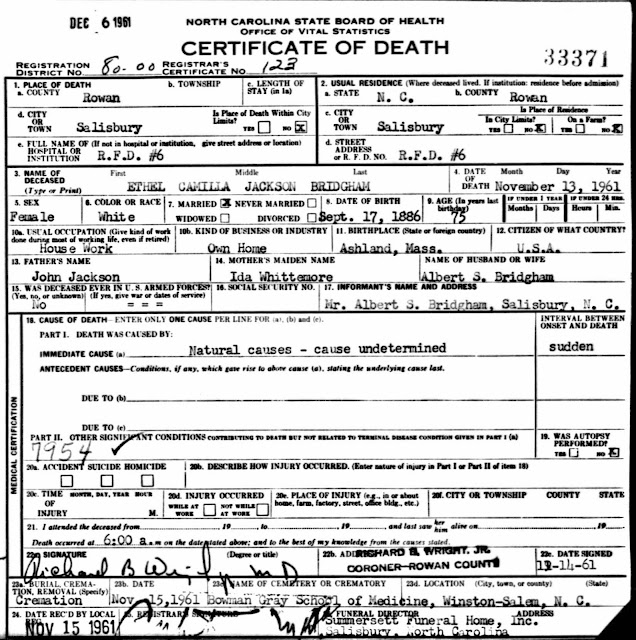 |
| Ethel Camilla Jackson Bridgham certificate of death. |
By now, my fellow Sepians are scratching their heads wondering what any of this has to do with this week's Sepia Saturday challenge—no boats, water, steamers, piers, or writing on photographs in sight. But the main thing I noticed in the image prompt were the TREES, especially the tall one in the foreground. It immediately brought to mind the top photo of Ethel with the trees. So naturally I had to blog about her. Nearly all of my photos in this story has a tree in it, or at least a bush. Find out how other interpreted this week's image prompt by following the links on the Sepia Saturday blog.
Thanks for dropping by.
Source Citations
[1] North Carolina State
Board of Health, Office of Vital Statistics, death certificate 123 (1961),
Ethel Camilla Jackson Bridgham; digital image, Ancestry.com, "North
Carolina Death Certificates, 1909-1975,"(http://www.ancestry.com :
accessed 9 Jan 2011).
[2] 1900 U.S. census,
Middlesex County, Massachusetts, population schedule, Malden, enumeration
district (ED) 831, sheet 10A, p. 154 (stamped), dwelling 178, family 225, John
H. Jackson household; digital images, Ancestry.com (http://www.ancestry.com
: accessed 14 Jan 2012); citing National Archives and Records Administration
microfilm T623, roll 662.
[3] 1910 U.S. census,
Suffolk County, Massachusetts, population schedule, Boston Ward 20, enumeration
district (ED) 1564, sheet 13A, p. 12 (stamped), dwelling 203, family 310, John
H. Jackson household; digital images, Ancestry.com (http://www.ancestry.com
: accessed 24 Jul 2009); citing National Archives and Records Administration
microfilm T624, roll 622.
[4]
"Massachusetts,
Deaths, 1841-1915", 352, no. 8588, John H. Jackson; digital image,
"Deaths Registered in the City of Boston," FamilySearch (http://www.familysearch.org:
26 Sep 2011); Massachusetts State Archives, Massachusetts Division of Vital
Statistics, State House, Boston, Massachusetts. United States.
[5] 1920 Census for
Boston, Suffolk county, Massachusetts, Record Type: 1920U.S. Census, Location:
Boston, Suffolk County, Massachusetts, Fhl FilmNo: 1820737, Record Info:
population schedule, Film: Micropublication Series T625, Roll 737, William G.
Brown household, Boston, ED 430, SD 6, sheet 4B, dwelling 58, family 83, lines
80-85, enumerated on 9 January 1920.
[6] Town of Ashland,
Middlesex County, Massachusetts, deaths recorded with the Ashland Town Clerk
(1924), Ida Estelle Jackson.
[7] 1930 U.S. census,
Suffolk County, Massachusetts, population schedule, enumeration district (ED)
150, sheet 12A, p. 130 (stamped), family 3, Ethel C. Jackson; digital images, Ancestry.com (http://www.ancestry.com
: accessed 7 Dec 2002); citing National Archives and Records Administration
microfilm T626, roll 945.
[8] Suffolk County Probate
Court: Harry Edward Jackson vs. Frances O. Jackson; Divorce Case Docket No.
11502 (1932).
[9] 1930 U.S. census, Cook
County, Illinois, population schedule, Chicago city, precinct 7, ward 46th pt,
block 123, enumeration district (ED) 1699, sheet 6B, dwelling 61A, family 100A,
Francis Jackson; digital images, Ancestry.com (http://www.ancestry.com
: accessed 16 Jan 2011); citing National Archives and Records Administration
microfilm T626, roll 488.
[10] Florida State Board of
Health, Bureau of Vital Statistics, death certificate State file no. 23594,
Registrar's no. 1368 (1941), Harry Edward Jackson.
[11] Interview of Harry’s
granddaughters by Sherri Hessick, 2002.
[12] North Carolina State
Board of Health, Office of Vital Statistics, death certificate 123 (1961),
Ethel Camilla Jackson Bridgham; digital image, Ancestry.com, "North
Carolina Death Certificates, 1909-1975,"(http://www.ancestry.com :
accessed 9 Jan 2011).
[13] Maine State Archives,
Albert Fayette Bridgham; digital image, Ancestry.com Operations, Inc., Maine
Birth Records, 1621-1922 (http://www.ancestry.com : accessed 13 Feb
2013); "Pre 1892 Delayed Returns"; Roll #: 12.
[14] 1940 U.S. census,
Norfolk County, Massachusetts, population schedule, Braintree, enumeration
district (ED) 11-10, sheet 2A, household 29, Albet F. Bridgham household;
digital images, Ancestry.com (http://ancestry.com : accessed 3 Aug
2012); citing National Archives and Records Administration microfilm T627, roll
1624.
[15] "U.S. City
Directories," database, Ancestry.com (http://www.ancestry.com
: accessed 5 Jul 2012), entry for Albert F. and Emily M. Bridgham; citing
Lothrop's Braintree Directory (1928), p 49.
[16] North Carolina State
Board of Health, Office of Vital Statistics, death certificate 123 (1961),
Ethel Camilla Jackson Bridgham; digital image, Ancestry.com, "North
Carolina Death Certificates, 1909-1975,"(http://www.ancestry.com :
accessed 9 Jan 2011).
[17] Find a Grave,
online index (http://www.findagrave.com : accessed 15 Feb 2013), entry for
Camilla J. Bridgham.
[18] North Carolina State
Board of Health, Office of Vital Statistics, death certificate 154 (1965),
Albert Fayette Bridgham; digital image, Ancestry.com, "North Carolina
Death Certificates, 1909-1975,"(http://www.ancestry.com : accessed 16 Jan
2011).
[19] Find a Grave, online index
(http://www.findagrave.com : accessed 15 Feb 2013), entry for Albert F.
Bridgham.
